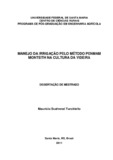| dc.creator | Turchiello, Maurício Scalvenzi | |
| dc.date.accessioned | 2013-06-06 | |
| dc.date.available | 2013-06-06 | |
| dc.date.issued | 2011-09-26 | |
| dc.identifier.citation | TURCHIELLO, Maurício Scalvenzi. Management of irrigation method for the culture of Penmam Monteith vine. 2011. 87 f. Dissertação (Mestrado em Engenharia Agrícola) - Universidade Federal de Santa Maria, Santa Maria, 2011. | por |
| dc.identifier.uri | http://repositorio.ufsm.br/handle/1/7560 | |
| dc.description.abstract | This study evaluated the effect of different irrigation levels by the yield components
and quality of fruit of vine. The experiment was conducted at the experimental
cultivation of grapes in the Polytchnic School of University of Santa Maria in Santa
Maria, RS, and was utilized the variety Vênus, by the trellis way beteween october 1,
2010 and january 5, 2011 for gain the experiment data. The experimental design was
ramdomized blocks with five treatments and four replications. It was determined a
irrigation level of reference in accordance with the characteristic curve of water
retention in soil. The irrigations were performed whenever the cumulative
evapotranspiration in the period approaching the value of water deth reference.
Irrigations treatments were called T2, T3, T4 and T5 corresponding the fractions 50,
75, 100, and 125% of water deth reference, and a control treatment (T1) that
received no irrigation. It was evaluated the following parameters: by the plant,
productivity and number of bunches.plant-1, by the fruit, weight, lenght and width of
the bunch, number of the berries.cluster-1, weight of five berries, berry weight and
diameterof of the stalk, hydrogenic potential and total soluble solids. The data used
to evaluated the parameters through regression analysis are homogeneous and
normal, without changes. The resuts of this study showed a significant difference
(5%) for some parameters evaluated between the irrigated treatments and the
control. Treatment with the highest productivity was the T4, with a yield of 17.794
kg.ha-1, an increase in productivity of 72,84% over the treatment without irrigation,
however the effect on quality of the bunch was not significant. Given these results,
the conditions under which the experiment was conducted, it is concluded that for the
culture of the vine there is an increase in productivity related to the increase of
irrigation water applied to a certain limit, after wich this increase in prodictivity is
lower, without changind the quality of fruit. | eng |
| dc.format | application/pdf | por |
| dc.language | por | por |
| dc.publisher | Universidade Federal de Santa Maria | por |
| dc.rights | Acesso Aberto | por |
| dc.subject | Irrigação | por |
| dc.subject | Videira | por |
| dc.subject | Gotejamento | por |
| dc.subject | Irrigation | eng |
| dc.subject | Vine | eng |
| dc.subject | Drip | eng |
| dc.title | Manejo da irrigação pelo método Penmam Monteith na cultura da videira | por |
| dc.title.alternative | Management of irrigation method for the culture of Penmam Monteith vine | eng |
| dc.type | Dissertação | por |
| dc.description.resumo | Com o objetivo de avaliar o efeito de diferentes lâminas de irrigação em
relação a produtividade, aos componentes de rendimento e aos atributos físicoquimicos
do mosto da cultura da videira, foi conduzido um experimento na área
experimental de cultivo de uvas no Colégio Politécnico da Universidade Federal de
Santa Maria no município de Santa Maria - RS. Foi utilizada a cultivar Vênus,
conduzida sob sistema de latada durante o período de 01 de outubro de 2010 a 05
de janeiro de 2011. A área onde foi instalado o experimento situa-se ao lado da
estação meteorológica da Universidade Federal de Santa Maria do qual foram
retirados os dados climáticos para o cálculo da evapotranspiração de referência pelo
método de Penman-Monteith. O delineamento experimental utilizado foi blocos
casualizados com cinco tratamentos e quatro repetições. Foi determinada uma
lâmina de irrigação de referência. Os tratamentos das irrigações realizadas foram
chamados de T2, T3, T4 e T5 e correspondem às frações de 50, 75, 100, 125% da
lâmina de irrigação de referência, e um tratamento testemunha (T1) que não
recebeu irrigação. Foram avaliados parâmetros da planta (produtividade e número
de cachos.planta-1), do cacho (peso dos cachos, dimensões dos cachos, número de
bagas.cacho-1, peso de cinco bagas, diâmetro das bagas e peso do engaço) e do
mosto (pH e teor de sólidos solúveis totais). Os resultados obtidos neste trabalho
mostraram que houve diferença significativa para os parâmetros avaliados, entre os
tratamentos irrigados e a testemunha. O tratamento que apresentou maior
incremento de produtividade foi o T4, com rendimento de 17.794 Kg.ha-1,
correspondendo a um aumento de produtividade 72,84% em relação ao T1 sem
irrigação, no entanto, o efeito sobre os atributos físico-quimicos do mosto não foi
significativo. Diante desses resultados, nas condições em que o experimento foi
realizado, conclui-se que para a cultura da videira, ocorre um aumento de
produtividade relacionado ao aumento da lâmina de irrigação, até um determinado
limite, após este limite, o incremento de produtividade é reduzido. | por |
| dc.contributor.advisor1 | Nishijima, Toshio | |
| dc.contributor.advisor1Lattes | http://lattes.cnpq.br/5427442140441172 | por |
| dc.contributor.referee1 | Fronza, Diniz | |
| dc.contributor.referee1Lattes | http://lattes.cnpq.br/9390269681166280 | por |
| dc.contributor.referee2 | Schons, Ricardo Luis | |
| dc.contributor.referee2Lattes | http://lattes.cnpq.br/9875030355020810 | por |
| dc.creator.Lattes | http://lattes.cnpq.br/0262857564148147 | por |
| dc.publisher.country | BR | por |
| dc.publisher.department | Engenharia Agrícola | por |
| dc.publisher.initials | UFSM | por |
| dc.publisher.program | Programa de Pós-Graduação em Engenharia Agrícola | por |
| dc.subject.cnpq | CNPQ::CIENCIAS AGRARIAS::ENGENHARIA AGRICOLA | por |


